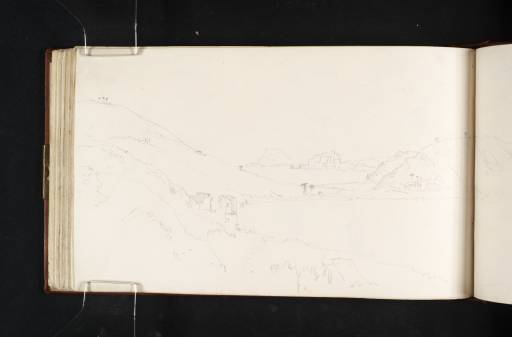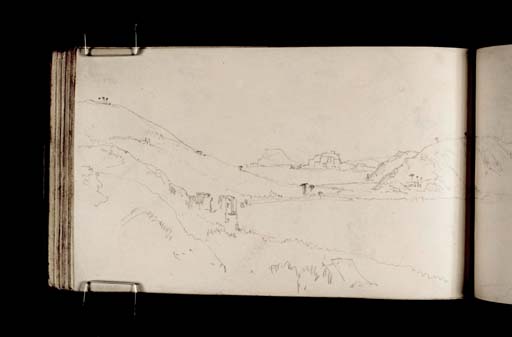Joseph Mallord William Turner Lake Avernus with the So-Called Temple of Apollo and a Distant View of Cape Misenum 1819
Image 1 of 2
Joseph Mallord William Turner,
Lake Avernus with the So-Called Temple of Apollo and a Distant View of Cape Misenum
1819
Joseph Mallord William Turner 1775–1851
Folio 71 Verso:
Lake Avernus with the So-Called Temple of Apollo and a Distant View of Cape Misenum 1819
D15696
Turner Bequest CLXXXIV 69 a
Turner Bequest CLXXXIV 69 a
Pencil on white wove paper, 122 x 197 mm
Accepted by the nation as part of the Turner Bequest 1856
References
1909
A.J. Finberg, A Complete Inventory of the Drawings of the Turner Bequest, London 1909, vol.I, p.545, as ‘Island of Ischia in distance’.
1984
Cecilia Powell, ‘Turner on Classic Ground: His Visits to Central and Southern Italy and Related Paintings and Drawings’, unpublished Ph.D thesis, Courtauld Institute of Art, University of London 1984, pp.180 and note 42, 424, 492 note 44, reproduced pl.105, as ‘Lake Avernus with the Temple of Apollo and a distant view of Cape Misenum’.
1987
Cecilia Powell, Turner in the South: Rome, Naples, Florence, New Haven and London 1987, p.79 notes 35 and 37.
As Cecilia Powell first identified, the subject of this sketch is Lake Avernus, a volcanic crater lake near Pozzuoli, which is represented in classical mythology as the entrance to the underworld.1 The composition, which spills over onto the opposite sheet of the double-page spread, see folio 72 (D15697; Turner Bequest CLXXXIV 70), depicts the view looking south from a point above the lake near present-day Via Montenuovo Licola Patria. The ruin on the eastern shore to the left is a Roman thermal bath hall known as the so-called Temple of Apollo, whilst visible in the bay beyond are the castle of Baiae and the promontory of Cape Misenum (present-day Capo Miseno).
This view was a popular one with artists and was well known to Turner through the work of landscapists such as Richard Wilson (1713–1782).2 He had already painted two oil compositions of the vista prior to seeing it for himself: Aeneas and the Sibyl, Lake Avernus circa 1798 (Tate N00463); and Lake Avernus: Aeneas and the Cumaean Sibyl circa 1814–15 (Yale Center for British Art),3 both of which are based upon a drawing by Sir Richard Colt Hoare (1758–1838), who also commissioned and owned the latter picture.4 A related pencil study can be found in the Turner Bequest (Tate D02381; Turner Bequest LI N). Lake Avernus is also the setting for a later oil painting, The Golden Bough exhibited 1834 (Tate N00371).5
Despite his familiarity with Lake Avernus, Turner made several on-the-spot sketches which are scattered throughout the Gandolfo to Naples sketchbook, see folios 19 verso, 27 verso, 34 verso–35, 71 and 72, 77–76 (D15592, D15608, D15622–D15623, D15695, D15697, D15707–D15709; Turner Bequest CLXXXIV 19a, 26a, 33a–34, 69, 70, 75–76).
Nicola Moorby
June 2010
How to cite
Nicola Moorby, ‘Lake Avernus with the So-Called Temple of Apollo and a Distant View of Cape Misenum 1819 by Joseph Mallord William Turner’, catalogue entry, June 2010, in David Blayney Brown (ed.), J.M.W. Turner: Sketchbooks, Drawings and Watercolours, Tate Research Publication, December 2012, https://www


